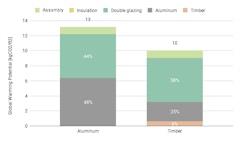
Steel As A Curtain Wall Framing Material
This paper will explore steel forming methods other than cold drawn or hot rolled processes, and how they allow steel to be utilized as the primary

This paper will explore steel forming methods other than cold drawn or hot rolled processes, and how they allow steel to be utilized as the primary

The construction industry is one of the greatest sources of pollution, where 39% of global energy-related carbon emissions are attributed to



The Science and Engineering Complex (SEC) on the Allston Campus is the largest new building at Harvard University in recent decades with a footprint

The building envelope is at the intersection of embodied and operational emissions. Curtain wall specifically could play an important role in
Facade systems of various transparent and opaque materials and systems are increasingly becoming integrated components of modularized facade



Today, about 40% of all buildings in the U.S. still have single-pane windows, and ~70% of the existing building stock is estimated to suffer from
Climate change goals will require significant improvements in the way buildings are constructed and operated. Building reuse can combat climate